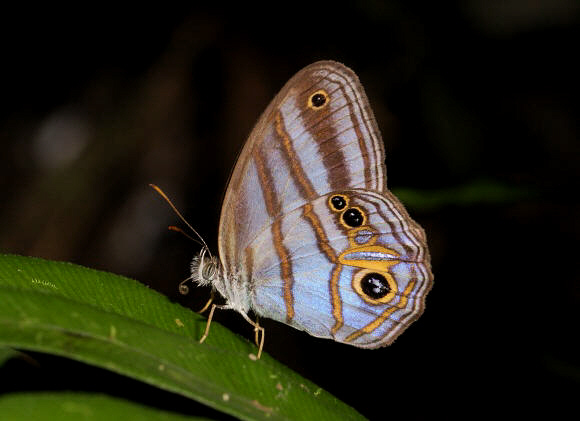
Introduction
There are 1100 known species of Satyrinae in the neotropical region. About 400 of these are placed in the Euptychiina. Butterflies within this tribe include the “ringlet” genera Euptychia, Magneuptychia, Harjesia, Cissia, Caeruleuptychia, Magneuptychia, Harjesia, etc.; together with Oressinoma and the various “wood nymph” genera i.e. Parataygetis, Posttaygetis, and Taygetis. Most are inhabitants of the forest understorey and tend to fly close to the ground. They generally avoid sunlight and prefer to fly at dawn or on cloudy days when light levels and temperatures are low.
Until fairly recently almost all of the “ringlets” were placed in the genus Euptychia, but revisions by Forster and Lamas divide this “convenience” genus into a number of smaller genera, on the basis of anatomical differences and larval foodplants. There are 42 species of “blue ringlets”, now variously allocated to the genera Caeruleuptychia, Cepheuptychia, and Chloreuptychia.
The 12 Chloreuptychia species are characterised by having ovoid forewings, a subtle blue sheen on the underside, and a pair of elongated silvery ocelli within the series of eyespots on the underside hindwings.
Chloreuptychia herseis occurs east of the Andes from Surinam and Guyana, south to Peru and east across Brazil to Rio de Janeiro.
Habitats
This species is confined to rainforest habitats at altitudes between about 100-1200m.
Lifecycle
I have no data regarding herseis, but it is reasonable to assume that the lifecycle is similar to that of Chloreuptychia arnaca, which is described below:
The egg is globular, shining white in colour, and laid singly on grasses. Chloreuptychia arnaca lays on Eleusine, Oplismenus, and Ichnanthus (Poaceae) where it grows around the base of trees. The larva is mottled in shades of brown, and has a row of diamond-shaped marks along the back. Its head is black with a pair of short horns that bear auxiliary spines. The tip of the abdomen bears a pair of caudal prongs. In common with almost all other Satyrines, the larvae feed nocturnally. The pupa of arnaca is mottled in shades of brown. Chloreuptychia pupae are typically wedge-shaped, and are formed attached by the cremaster to a stem, projecting horizontally.
Adult behaviour
The butterflies inhabit the understorey and are usually only seen along the darker and narrower trails. They don’t visit flowers but feed instead at decomposing fungi and bird droppings. Most of the time they sit motionless on leaves in the shade, and if disturbed they generally fly a distance of no more than 3 or 4 meters, and then re-settle.
It is likely that the wings reflect high levels of ultraviolet, enabling the butterflies to locate potential mates visually in the dark environment where they breed. The vertical lines on the underside are an example of disruptive coloration. They help break up the outline of the wings into separate shapes, making it more difficult for a bird to detect the butterfly. If, however, a bird succeeds in discovering where it has settled, the butterfly has a secondary defense in the form of the ocelli on the underside hindwings. These function to divert attacks away from the butterfly’s vulnerable body, allowing it to escape with nothing worse than a pecked wing.
